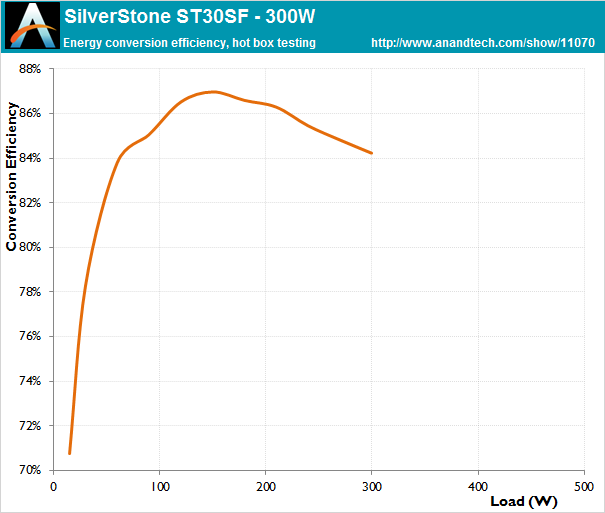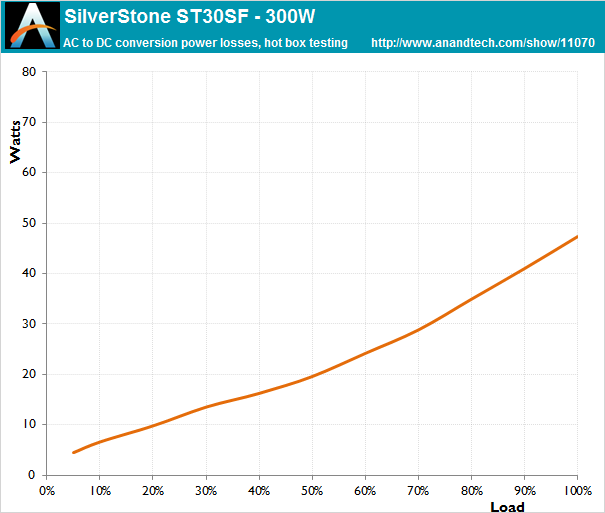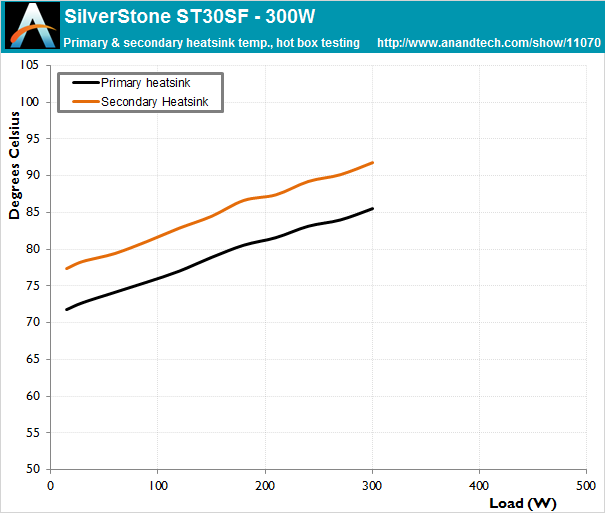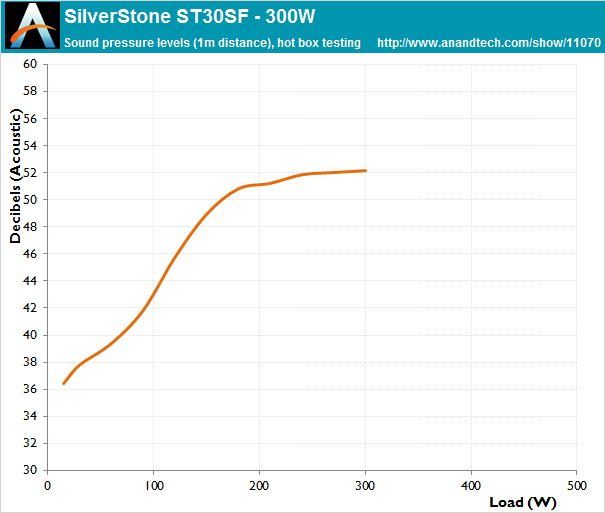The Silverstone ST30SF & ST45SF SFX Power Supply Review
by E. Fylladitakis on January 26, 2017 9:00 AM EST- Posted in
- Cases/Cooling/PSUs
- PSUs
- 80Plus Bronze
- SilverStone
- SFX
- ST30SF
- ST45SF
Hot Test Results
As we can see from their performance tables, the ST30SF and the ST45SF both display very good power quality figures for PSUs of their class. The filtering figures of the ST30SF are better, with a maximum ripple of about 42 mV on the 12V line under maximum load. The ST45SF reached up to 64 mV on the 12V line under maximum load, but that was to be expected given its much higher output. If we were to compare the two units on a per-watt basis, the ST45SF does deliver better power quality figures, which is to be expected considering its more capable electronic components. The voltage regulation of both units is almost identical, with an average of about 1.7% on the 3.3V/5V lines and 1.9% on the 12V line.
| SilverStone ST30SF Main Output | ||||||||
| Load (Watts) | 60.95 W | 151.64 W | 226.57 W | 299.92 W | ||||
| Load (Percent) | 20.32% | 50.55% | 75.52% | 99.97% | ||||
| Amperes | Volts | Amperes | Volts | Amperes | Volts | Amperes | Volts | |
| 3.3 V | 1.31 | 3.37 | 3.28 | 3.35 | 4.91 | 3.33 | 6.55 | 3.32 |
| 5 V | 1.31 | 5.1 | 3.28 | 5.08 | 4.91 | 5.05 | 6.55 | 5.03 |
| 12 V | 4.09 | 12.19 | 10.23 | 12.12 | 15.35 | 12.08 | 20.47 | 11.98 |
| Line | Regulation (20% to 100% load) |
Voltage Ripple (mV) | |||||
| 20% Load | 50% Load | 75% Load | 100% Load | CL1 12V |
CL2 3.3V + 5V |
||
| 3.3V | 1.6% | 12 | 10 | 10 | 12 | 10 | 12 |
| 5V | 1.5% | 8 | 12 | 12 | 16 | 10 | 12 |
| 12V | 1.8% | 14 | 24 | 28 | 42 | 38 | 20 |
Even though SilverStone rates the new revision models at 40 °C, they had no problem reaching their maximum power output inside our hotbox. Unexpectedly, their energy conversion efficiency dropped only very slightly as well, with the average nominal load (20-100%) efficiency dropping down to 85.6% and 85.8% for the ST30SF and the ST45SF respectively. We would expect the impact to be much higher considering their design and the very high temperatures, but both units proved us wrong.
| SilverStone ST45SF Main Output | ||||||||
| Load (Watts) | 91.65 W | 228.35 W | 338.28 W | 449.76 W | ||||
| Load (Percent) | 20.37% | 50.74% | 75.17% | 99.95% | ||||
| Amperes | Volts | Amperes | Volts | Amperes | Volts | Amperes | Volts | |
| 3.3 V | 1.69 | 3.38 | 4.22 | 3.37 | 6.33 | 3.32 | 8.44 | 3.31 |
| 5 V | 1.69 | 5.12 | 4.22 | 5.09 | 6.33 | 5.06 | 8.44 | 5.03 |
| 12 V | 6.33 | 12.21 | 15.83 | 12.17 | 23.75 | 12.01 | 31.66 | 11.99 |
| Line | Regulation (20% to 100% load) |
Voltage Ripple (mV) | |||||
| 20% Load | 50% Load | 75% Load | 100% Load | CL1 12V |
CL2 3.3V + 5V |
||
| 3.3V | 1.65% | 16 | 16 | 18 | 18 | 16 | 16 |
| 5V | 1.7% | 18 | 20 | 20 | 22 | 24 | 20 |
| 12V | 1.9% | 18 | 26 | 36 | 64 | 68 | 40 |

| Efficiency |

| Power Losses |
The low impact of the high temperature on the efficiency of the units hints that the active components of both units are significantly oversized for their design and power rating and could, in theory, sustain their power output with an ambient temperature of 50 °C. The operating temperatures however are very high, with the ST30SF reaching temperatures of nearly 92 °C under maximum load and the ST45SF a few degrees higher than that.

| Intake & Exhaust Air Temperature |

| Heatsink Temperature |
Under such operating conditions we can see that the fans of both units shoot up to their maximum speed before the units even reach 50% of their rated maximum power output. The ST45SF reached a maximum sound pressure level of about 56 dB(A), higher than the 52 dB(A) of the ST30SF, due to its more powerful fan. The more powerful fan proved to be more than a necessity, as the ST45SF can barely maintain nominal operating temperatures when heavily loaded.

| Sound Pressure Level |










30 Comments
View All Comments
jabber - Thursday, January 26, 2017 - link
PSU is a key component. Plus if you buy a quality one, it may well be the only part that carries over to the next build.Achaios - Wednesday, February 1, 2017 - link
Speaking of it, the only component that has carried itself over to my present build from my first 2008 gaming PC build, is the DVD-ROM drive. It comes very handy with games such as GTAV and the 6 DVD's that came with it.I admit though that if I knew what I know now about PC's, it is possible that I would have kept the original Cooler Master PSU that came with my Cooler Master case, provided that it wouldn't have failed.
Samus - Thursday, January 26, 2017 - link
I personally love PSU reviews. It's interesting to see where corners can be cut to shave costs, and how different manufactures market and how OEM's approach different designs.jabber - Friday, January 27, 2017 - link
I think on my 5820K build back in May I spent more time looking up the PSU than any other part.Samus - Saturday, January 28, 2017 - link
I believe it. I've had a PC Power and Cooling 750 Quad since 2008 go through a PC I kept for 3 years, a mining rig, and now back to a SLI gaming pc. It has had an incredibly hard life being run at 90% load 24/7 on the mining rig for almost 4 year so non-stop, and now it's driving a Xeon workstation with two 980's...It's quiet, has been reliable, and it wasn't even that expensive ($120?) it's 80 Plus but I don't know what tier.
PSU is something everyone should pay attention too. A crappy one could actually result in an unstable PC, especially under load, and a quality one will save money over the long run.
ZipFreed - Tuesday, January 31, 2017 - link
This, so much this. I've seen so many builds over the years both from friends in RL and all over the web with high-end parts and absolutely garbage PSU choices. If you're going to spend $500+ on a CPU you can absolutely afford the +$50 necessary for a quality PSU.I was finally able to build my own rig when I was about 10 years old after always using hand me down parts. I did a ton of research and a quality PSU was something I consistently saw mentioned. Used PCP&C Silencer and have continued to use high-quality PSU's and am currently pushing 30. In that time I've never had a single PSU related failure and have peace of mind knowing my hardware is covered if something happens.
I've been using mainly Seasonic the past 5-6+ years and generally re-use both my PSU, Case and Watercooling loop with 2-3+ different CPU/GPU/Mobo combos before refreshing everything every 18-24 months and repurposing the old stuff. First SS unit is almost 8 years old and it's ran a heavily overclocked system from day 1 and never skipped a beat and is still going strong.
PSU is the lifeblood of your machine, why skimp out?
just4U - Tuesday, January 31, 2017 - link
many on this site likely care simply because they build their own PCs and build for others... I always pay particular interest to which oem is making the unit..and what the reviewers thoughts are on the overall quality.caten - Wednesday, February 1, 2017 - link
I care. +1 for PSU reviews, especially for the more mainstream wattage sizes. I have a mITX system so another +1 for SFX.NZLion - Thursday, January 26, 2017 - link
These seem like very low wattages for modern power supplies. Is my perspective skewed? Is this likely sufficient for the sort of system that would normally use a PSU in the SFX formfactor?For reference, I have a system that uses an SFX PSU, but I went for a 600W unit and even that I felt was a worryingly small margin over the requirements of my system.
flgt - Thursday, January 26, 2017 - link
I would have thought most SFX power supplies are used in small, lower performance machines. Also most likely integrated graphics. So I'm thinking average system power demands of around 100W. As other posters have noted, it's not a good idea to install oversized power supplies as the increased static power kills efficiency at light loads.